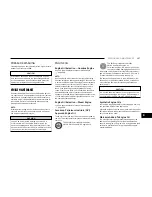
Engine Coolant Checks
Check the engine coolant (antifreeze) protection every
12 months (before the onset of freezing weather, where
applicable). If the engine coolant is dirty or rusty in
appearance, the system should be drained, flushed and
refilled with fresh coolant. Check the front of the A/C
condenser or radiator for any accumulation of bugs,
leaves, etc. If dirty, clean by gently spraying water from
a garden hose vertically down the face of the A/C con-
denser or the back of the radiator core.
Check the engine cooling system hoses for brittle rub-
ber, cracking, tears, cuts and tightness of the connec-
tion at the coolant recovery bottle and radiator. Inspect
the entire system for leaks.
DO NOT REMOVE THE COOLANT PRESSURE CAP WHEN
THE COOLING SYSTEM IS HOT.
Cooling System — Drain, Flush And Refill
NOTE:
Some vehicles require special tools to add coolant prop-
erly. Failure to fill these systems properly could lead to
severe internal engine damage. If any coolant is needed
to be added to the system please contact an authorized
dealer.
If the engine coolant (antifreeze) is dirty or contains
visible sediment, have an authorized dealer clean and
flush with Organic Additive Technology (OAT) coolant
(conforming to MS.90032).
For the proper maintenance intervals
Selection Of Coolant
For further information
NOTE:
•
Mixing of engine coolant (antifreeze) other than
specified Organic Additive Technology (OAT) engine
coolant, may result in engine damage and may
decrease corrosion protection. OAT engine coolant is
different and should not be mixed with Hybrid
Organic Additive Technology (HOAT) engine coolant
or any “globally compatible” coolant. If a non-OAT
engine coolant is introduced into the cooling system
in an emergency, the cooling system will need to be
drained, flushed, and refilled with fresh OAT coolant
(conforming to MS.90032), by an authorized dealer
as soon as possible.
•
Do not use water alone or alcohol-based engine
coolant products. Do not use additional rust inhibi-
tors or anti-rust products, as they may not be com-
patible with the radiator engine coolant and may
plug the radiator.
•
This vehicle has not been designed for use with pro-
pylene glycol-based engine coolant. Use of propyl-
ene glycol-based engine coolant is not
recommended.
•
Some vehicles require special tools to add coolant
properly. Failure to fill these systems properly could
lead to severe internal engine damage. If any cool-
ant is needed to be added to the system please con-
tact an authorized dealer.
Adding Coolant
Your vehicle has been built with an improved engine
coolant (OAT coolant conforming to MS.90032) that
allows extended maintenance intervals. This engine
coolant (antifreeze) can be used up to ten years or
150,000 miles (240,000 km) before replacement. To
prevent reducing this extended maintenance period, it
is important to use the same engine coolant (OAT cool-
ant conforming to MS.90032) throughout the life of
your vehicle.
Please review these recommendations for using
Organic Additive Technology (OAT) engine coolant that
meets the requirements of the manufacturer Material
Standard MS.90032. When adding engine coolant:
•
We recommend using Mopar® Antifreeze/Coolant
10 Year/150,000 Mile (240,000 km) Formula OAT
that meets the requirements of the manufacturer
Material Standard MS.90032.
•
Mix a minimum solution of 50% OAT engine coolant
that meets the requirements of the manufacturer
Material Standard MS.90032 and distilled water.
Use higher concentrations (not to exceed 70%) if
temperatures below −34°F (−37°C) are anticipated.
Please contact an authorized dealer for assistance.
•
Use only high purity water such as distilled or deion-
ized water when mixing the water/engine coolant
solution. The use of lower quality water will reduce
the amount of corrosion protection in the engine
cooling system.
298
SERVICING AND MAINTENANCE
Summary of Contents for CHASSIS CAB 2024
Page 69: ...GETTING TO KNOW YOUR INSTRUMENT PANEL MIDLINE INSTRUMENT CLUSTER GASOLINE 67 3...
Page 71: ...HIGHLINE INSTRUMENT CLUSTER GASOLINE GETTING TO KNOW YOUR INSTRUMENT PANEL 69 3...
Page 75: ...MIDLINE INSTRUMENT CLUSTER DIESEL GETTING TO KNOW YOUR INSTRUMENT PANEL 73 3...
Page 77: ...HIGHLINE INSTRUMENT CLUSTER DIESEL GETTING TO KNOW YOUR INSTRUMENT PANEL 75 3...
Page 357: ......
Page 358: ......






























